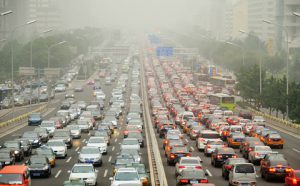Two-thirds of the air pollution suffered by Beijing is generated from within the city, while the remainder drifts in from surrounding provinces such as Hebei, according to analysis from China’s environment ministry.
Analysis from the Ministry of Environmental Protection, published Wednesday, indicated that of the PM 2.5 pollution generated from within the city itself, 31% came from motor vehicles, 22% from coal burning, 18% from industrial production, and 14% from dust given off by construction and other sources.
Dust and industrial pollution are the leading causes of air pollution in Shanghai, Tianjin, and Ningbo, while coal burning is the number in the primary culprit in Hebei’s capital Shijiazhuang and in the southern city of Nanjing.
The figures suggest that while emissions from coal-intensive heavy industry in surrounding provinces is a major factor in worsening smog in Beijing, most of the underlying causes stem from the capital’s rapid expansion and economic growth.
Last month, a widely-viewed documentary ‘Under The Dome’ used government data to show that a rapid increase in car use fuelled by poor quality petrol and diesel was a major cause of smog in many Chinese cities, particularly those urban areas where there is relatively little industrial production.
In recent weeks, Beijing has taken action against some of its homegrown sources of smog, closing two of its remaining three coal-fired power plants and placing temporary restrictions on the number of cars allowed on the city’s roads through odd-even licence plate restrictions.
“Severe” pollution afflicted Beijing and neighbouring Hebei for 156 days in 2014, or 42 percent of the year, according to MEP data, only a small decrease on 2013’s figures despite the declaration of “a war on pollution” over a year ago.
Greenpeace analyst Lauri Myllyvirta said a 4% drop in PM 2.5 concentrations from 2013 to 2014 could be partially explained by weather conditions, which had been less favourable to the formation of smog formation, while a milder winter meant less fuel was burnt for heating.
He added: “A fall in coal consumption and particularly the fall in steel output in Hebei has also contributed, along improvements in pollution control in power plants and factories.”
